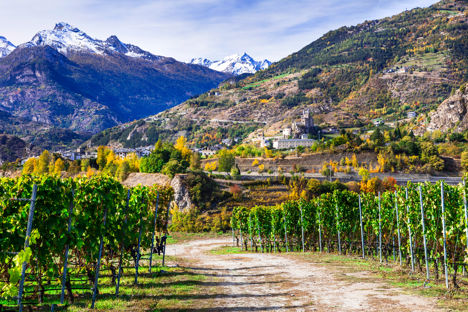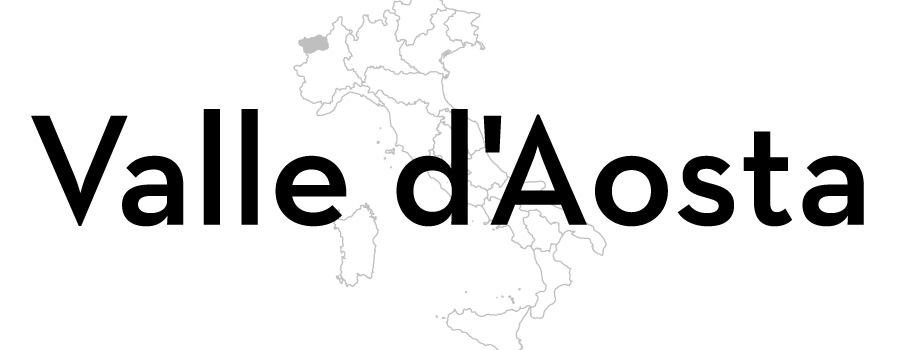
The complete foodie guide to Valle d'Aosta
Italy’s smallest and least populated region is where you’ll find hearty alpine cookery at its finest. Read our guide to get a better understanding of why this tiny part of Italy is home to much more than ski resorts and mountain climbing.
The complete foodie guide to Valle d'Aosta
Italy’s smallest and least populated region is where you’ll find hearty alpine cookery at its finest. Read our guide to get a better understanding of why this tiny part of Italy is home to much more than ski resorts and mountain climbing.
When two countries share a border, you’ll often find the two cultures fuse together to create something new. That’s certainly the case in Valle d’Aosta, Italy’s tiniest region. Surrounded by Piedmont to the south and east, France to the west and Switzerland to the north, it’s a place of mountains, peaks and valleys – which also makes it the most sparsely populated part of Italy, too.
The Alps stretch across eight different countries, and wherever you are the food shares many traits: hearty, humble, filling and rich. After all, the colder climate means there’s no room for the tomatoes, basil and light salads of southern Italy (although it still gets quite warm during the summer). In years past it was also tough to bring in products from other parts of the world due to the lack of transport links, so much of the local cuisine is based on what could be grown, reared and produced locally. In Valle d’Aosta, dairy is arguably the most important part of the local diet, with milk, butter and cheese (especially the PDO-protected Fontina) used with abandon in the majority of dishes. Beef and game are the most popular meats – although you’ll also see pork and goat on the menu – while locally grown nuts and orchard fruits are renowned for their incredible flavour.
Valle d’Aosta is officially bilingual, with both Italian and French spoken, but there’s also the native Valdôtain language, which is unique to the area. For such a small region – there are no sub-provinces and an estimated population of just 128,000 – it boasts an incredible food scene and strong, thriving culture. Read on for more information on what makes the ingredients, flavours and dishes of Valle d’Aosta so unique.
Ingredients and flavours
Of all the ingredients and food products found throughout Valle d’Aosta, Fontina cheese is the most prized. This alpine cheese has been made since the twelfth century and originated here, although you’ll now find versions made in other parts of Italy and around the world. The original and best is still made in the valley, however, and boasts PDO-protected status. Its strong, punchy aroma and taste make it an icon of Aostan cookery.
Other cheeses from the region include Toma (which is also made in Piedmont to the south) and Fromadzo, which is also PDO-protected. Dairy products make up a huge part of the local diet, and the butter, milk and cheese produced in the region is famed for its high fat content (especially towards the end of summer, when the cattle have been grazing on wild alpine pastures).
Mountain cattle are a vital part of Valle d’Aosta’s agricultural economy, and the animals supply the locals with both dairy and meat. Rich hearty beef stews, soups made with beef stock and salted beef grace many a table, but it’s not the only meat you’ll find in the region. Valdostana is the name given to the local breed of goat, which is used for both meat and dairy, and you’ll also find pork and local game on the menu.
Being in such a mountainous, sparsely populated region, the people of Valle d’Aosta are keen preservers, which means as well as jars full of jams and pickles, charcuterie is a common sight. The PDO-protected Jambon de Bosses, made up in the peaks right by the Swiss border, is the area’s most famous salumi. Flavoured with juniper berries, thyme and a variety of foraged herbs from the mountains, it is aged as a whole leg for at least a year. The ham is so popular in Valle d’Aosta that there’s even a festival held to celebrate it on the second Sunday of July each year in the town of Saint-Rhémy-en-Bosses.
There’s also Lard d’Arnad (also PDO-protected), a sort of local take on lardo, and plenty of sausages made from pork, blood, beef (known as motzetta) and even goat. However, the most unusual salumi to come from Valle d’Aosta has to be Teuteun – corned cow’s udder often served with sweet jams.
Vegetables don’t make up a huge part of the cuisine of Valle d’Aosta, as there is little land available for large-scale farming. Onions and cabbages are often thrown into stews and lots of local herbs are used to add freshness to dishes, but you’ll rarely find tomatoes, artichokes and other sunnier ingredients found further south. Fruit is a different matter – the alpine climate means apples and pears grow incredibly well and are full of flavour, often making their way into pies, pastries and preserves. Golden Delicious and Pippin apples are a particular local favourite, while little Martin Sec pears are often poached in syrup and local red wine.
Amongst the apple and pear orchards of Valle d’Aosta you’ll also see plenty of walnut and chestnut trees, both of which play a huge role in the local diet. In the autumn chestnuts are harvested and are usually served roasted alongside local salumi, chopped and stirred into hearty soups or preserved in local honey or grappa. Walnuts are usually reserved for the cheeseboard, but you’ll also find them used to flavour biscuits or other sweet dishes. They were traditionally grown in order to make walnut oil, but this industry has shrunk over the years as olive oil became more readily available in the local area.
The local bread (known as pan ner (‘black bread’)) is often made with rye flour as well as wheat flour, and is steeped in tradition. The earthy, nutty loaves are far removed from the lighter, whiter breads found further south, and represent the hearty, fibre-filled diet living in the mountains requires. This bread, along with plenty of polenta, is what the locals eat as their main source of carbohydrates – pasta (apart from gnocchi, often smothered in a cheese sauce) is rarely seen in the region, although you’ll sometimes find shapes made with chestnut flour.
The mountains of Valle d’Aosta might not boast the green, vineyard-covered rolling hills of Tuscany, but the local wines are particularly well suited to the alpine climate. Sharing a border with France means many similarities can be found in the wines of the two countries, and the mineral-rich flavours mountain wines create are prevalent in both the reds and the whites.
Grappa is also a very popular digestif in Valle d’Aosta; the perfect way to end a meal of hearty, rich dishes. Keep an eye out for génépy (or genepì), too – a herbal liqueur made from local mountain ingredients such as wormwood. While it originated over the border in France, this liqueur has become a favourite in Valle d’Aosta.
Famous dishes
You can’t talk about alpine cooking without talking about fondue, and while the dish is mostly associated with Switzerland, in Valle d’Aosta it’s just as popular. Known as fonduta in Italian, the Aostan version contains lots and lots of beloved Fontina cheese, as well as flour, milk, egg yolks and sometimes white truffle. Traditionally it is served with nothing more than pieces of local rye bread, although you will also see it served with potato gnocchi for dipping.
Cold mountain weather means big, hearty stews are needed – and carbonade Valdostana fits the bill perfectly. Over in Belgium, carbonade often refers to a beef stew cooked with beer, but in Valle d’Aosta plenty of red wine is used instead. Onions, beef and red wine are simmered slowly until meltingly tender, with local herbs and aromatics such as juniper berries added for extra flavour. It’s often served with rich, buttery polenta.
Italian ‘soups’ aren’t always thin and liquid; instead, they’re often more akin to loose stews made up of a few humble ingredients. This local seupa (or zuppa) is the perfect example of that, with layers of savoy cabbage, leftover bread and – of course – Fontina cheese gently simmered in beef stock. The result is a hearty, rich and incredibly filling dish that sums up alpine cooking beautifully.
As mentioned above, polenta is a main source of starch for the people of Valle d’Aosta, and one of the most popular ways of preparing it is concia – essentially lots of butter and Fontina cheese! The result is a creamy, rich side that’s perfect for serving alongside equally hearty stews.
Valle d’Aosta’s most famous sweet treat comes in the form of tegole (‘tile’) – tuile-like biscuits flavoured with hazelnuts and sometimes almonds, vanilla and honey (another local product held in high regard). They’re made from a loose batter, which is spread into thin circles on a tray then briefly baked until light, golden and crisp. Served with coffee, cream or chocolate, the aroma they create whilst in the oven is irresistible.



